Q: Greg, I enjoy all your car nostalgia columns, especially those you write about from the 1950 and 1960 decade. I am your age, 74, and remember you’ve written that most of the cars were well designed back then. I also remember in Auto Roundup magazine you did not like the General Motors 1958 cars but did like Chryslers. Why so? Frank Lorden, Chicago, Illinois.
A: Frank, the reason I liked the Chrysler family is because starting in 1957 all Chrysler cars were uniquely designed and quite good-looking. Chrysler called them their “forward look” design, utilizing new greenhouses, dual front headlights, and larger fin treatments that impressed the consumer so much that many switched from GM and Ford to Chrysler. The greenhouse of a vehicle is the “glassed” area above the fender line including the windshield, side and rear windows, and any pillars separating them.
Following some of the best years for car design from 1955 through 1957, many manufacturers went off the deep end by adding unneeded bulk, longer wheelbases, way too much chrome, and rear tail fins that by 1960 was totally out of control.
Enter the legendary Harley Earl, GMs head of design.
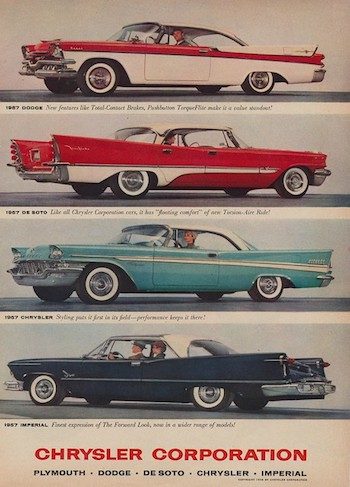
Chrysler, for 1957, introduced a completely all-new design of cars that were ahead of the curve. Compared to the competition, Chrysler’s modern, “forward look” designs were the best of all. (Chrysler)
I feel 1958 was the year Earl’s designs were so large and gaudy that his engineers took advantage of his being away from Detroit on a long business trip. While away, his design team decided to re-do its 1959 platforms after seeing the new Chrysler designs, thanks to then Earl understudy Bill Mitchell, who oversaw the design team at GM in his absence.
By the time Earl returned to the office, it was too late to change the designs and he reluctantly gave the okay to proceed with the Mitchell led layouts. You’ll notice that the 1959 Chevrolet, with its unique rear fin and tail lamp design and sibling Pontiac’s wide track and dual front grille were all-new, and to this day both are very popular collector cars. Ditto for Olds, Cadillac and Oldsmobile in all-new designs and all very popular.
A few of the cars that quickly come to mind as great designs include 1957 Chevy, 1957 Ford, 1956 Plymouth, 1953 Buick Skylark, 1956 Continental, 1956 Studebaker Hawk, 1956 Mercury, and the 1956 Packard Caribbean. I could keep going, but I think you get the point that prior to 1958 there were many great designs that to this day are highly sought after collector cars.
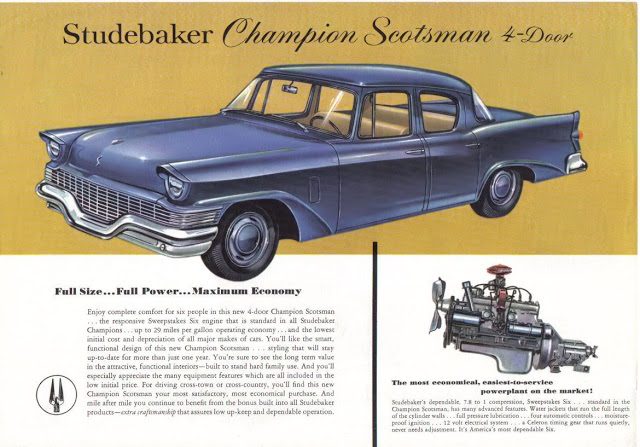
A worst example of design went to Studebaker with its 1958 Scotsman. Not only was it homely, but it also accelerated from zero to 60-mph in 21 seconds, which made just merging onto the nation’s turnpikes a more difficult task. (Studebaker)
When the new 1958 models arrived in late 1957, some of the most overgrown “boxy” designs appeared at the new car shows. Of the big three (GM, Ford, Chrysler), I still feel General Motors led the way with poor designs.
I recall the 1958 Oldsmobile was not much to look at, and the usually good looking Pontiac shared similarities with Olds. Buick, although I now really like the 1958, featured even more chrome than its siblings, and was very heavy looking in its final presentation. Even the 1958 Chevy, which was the best of the GM family, bulked up far beyond its predecessor beauty, the classic 1957 Chevy.
I remember sitting in all the new 1958 GM models at the Atlantic City Steel Pier entrance, where GM always had a huge, yearly display. Visiting the Steel Pier to see the “Diving Horse” and the new GM cars was always the highlight of my early years.
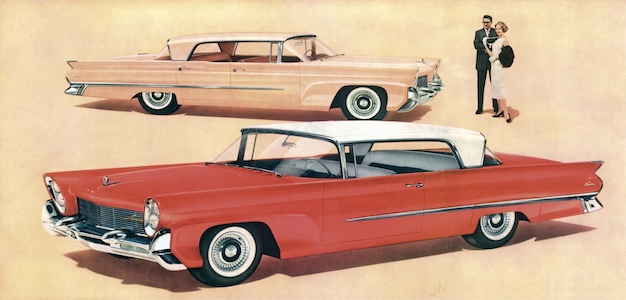
The 1958 Lincoln dropped jaws for the wrong reasons. Back then these behemoths needed large V8 engines to move more than 5,000-lb. curb weight forward. With six adults inside and some luggage, you were over 3-tons total. (Lincoln)
Meanwhile, Ford lost its way too, but just a little bit. I opine that the 1958 Ford was at least acceptable in looks, but still nowhere near its stunning 1957 models. A major mistake was the 1958 Mercury, which had already gained weight and an odd appearance in 1957. The Mercury, for 1958, completely deviated from what I’ve always said was one of the best car designs, as the 1955 and 1956 Mercury’s were outstanding. For whatever reason, everything seemed to say, “let’s add more weight and chrome to the Mercury, box it off and even add a backward tilted window that opens and then let’s add some really weird tail lamps.”
Perhaps the biggest eyesore from Ford was the new 1958 Lincoln, which grew to immense proportions in all manners. As for the all-new Edsel, its unique design wasn’t nearly as bad since there was nothing to compare it to.
Even the Thunderbird, which made positive impressions as Ford’s two-seat sports car from ’55 through ’57, fell to the 1958 “bigger” flaw. Although I do like the looks of the 1958 Thunderbird, it arrived as a bigger, heavy four-seater.
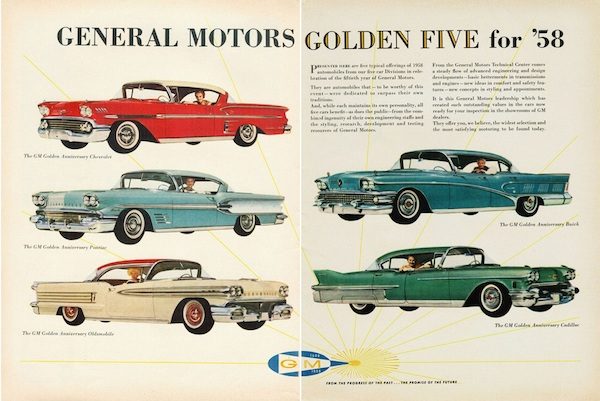
This ad for the five 1958 General Motors vehicles featured the new, albeit bulky and heavily chromed, Chevy, Pontiac, Cadillac, Oldsmobile and Buick. None will ever win any special design awards, although Chevrolet, Cadillac and Buick do attract collectors’ attention. (General Motors)
At Chrysler, things were different in a very good way. The “fin wars” began in earnest in 1957, and then took off. By 1958, some of the big rear wings, ala Plymouth and DeSoto, were sitting in the dealer showrooms and looking way different than before – but in a new and novel way. They looked awesome and most offered dual front headlights.
Of the big three manufacturers, I’d have to say the 1958 Chrysler family of cars were the best looking, including the Plymouth Belvedere that made it to Hollywood fame as “Christine”, and those beautiful Chrysler 300s. My favorite was the DeSoto Adventurer with a nice Hemi V8 stuffed under the hood.
Studebaker and Packard meanwhile merged their two companies successfully, yet financially failed miserably. This new company experienced immediate financial woes thanks to incorrect and badly flawed Studebaker bookkeeping. Packard put out its final model in 1958 while Studebaker’s 1958 model was a big, dull and ugly Studebaker Scotsman. This shabby looking, stripped-down car was a slow poke that ran zero to 60-mph in 21 seconds. Sales were atrocious, and the Studebaker / Packard nameplates were brought to their knees.
Studebaker, however, had a trump card to play to at least delay impending bankruptcy. First they eliminated the Packard models, much to the chagrin of loyal Packard consumers. Next they took the atrocious looking and poor selling Scotsman, added all-new sheet metal for a unique, smaller design and presto – the 1959 Studebaker Lark was born!
This Lark was an immediate hit with the buying public, thus saving the company at the last possible moment from insolvency. Packard? Take a close look at that 1958 Packard Station Wagon and you’ll easily see why this once prestigious model came to a sad ending thanks to Studebaker, which lasted until 1966 when the bankrupt axe finally fell.
Rambler, however, was in a good position back then. Although previous Rambler designs were decent, this manufacturer played it cool during some of the crazy fin design years and steadily added customers. Overall, 1958 was pretty good for Rambler as it did not cave to the “more chrome and huge” pressures that competing manufacturers bought into. Instead of the latest outrageous car fashion statements, Rambler motored along with some decent, even cute, designs.
Here, in 2023, a 1958 Rambler Cross Country Wagon looks worthy sitting alongside an immense 1958 Mercury Turnpike Cruiser at a Mecum or Barrett-Jackson auction.
Unfortunately, this Rambler / Mercury comparison can’t be said for that 1958 Studebaker Scotsman, proving the adage “sometimes less is more.”
(Greg Zyla is a syndicated auto columnist who welcomes reader questions on old cars, auto nostalgia and motor racing at greg@gregzyla.com or snail mail to Roosevelt St., Sayre, Pa. 18840.)

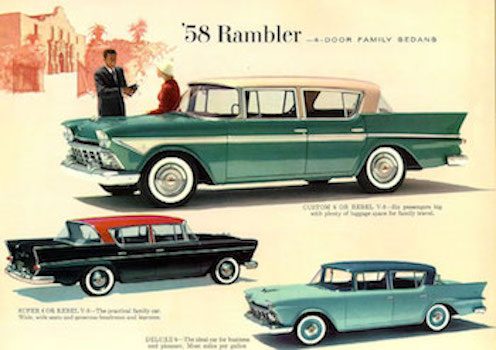

Be the first to comment on "Collector Car Corner; Chrysler’s 1957 ‘forward look’ family forced other manufacturers to re-think its design strategy"